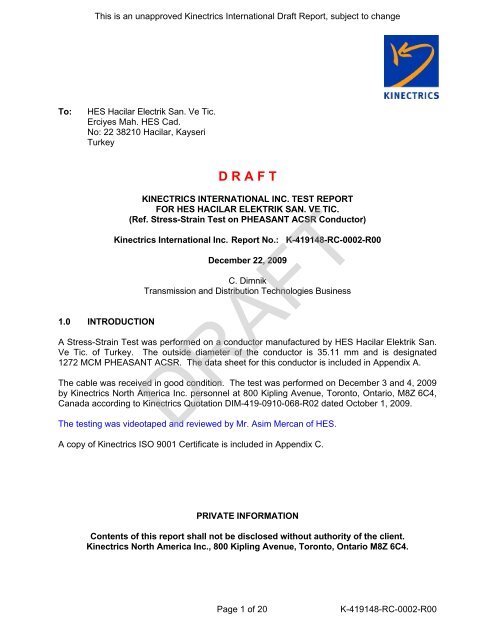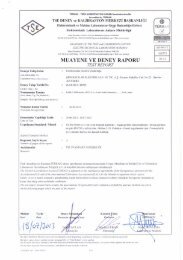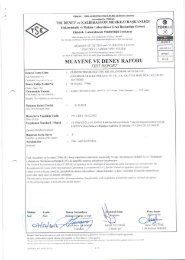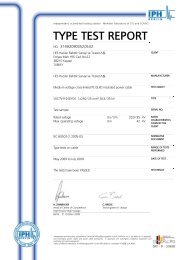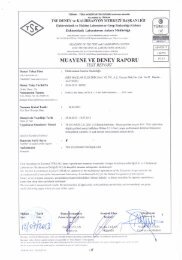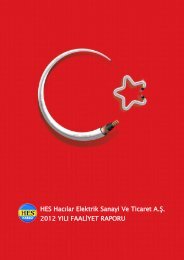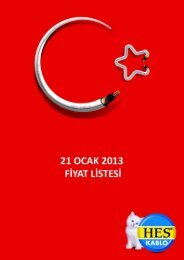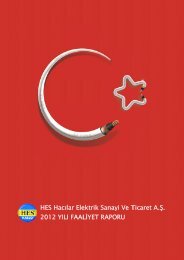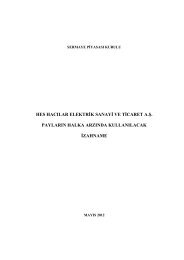D R A F T
D R A F T
D R A F T
Create successful ePaper yourself
Turn your PDF publications into a flip-book with our unique Google optimized e-Paper software.
This is an unapproved Kinectrics International Draft Report, subject to change<br />
To: HES Hacilar Electrik San. Ve Tic.<br />
Erciyes Mah. HES Cad.<br />
No: 22 38210 Hacilar, Kayseri<br />
Turkey<br />
1.0 INTRODUCTION<br />
D R A F T<br />
KINECTRICS INTERNATIONAL INC. TEST REPORT<br />
FOR HES HACILAR ELEKTRIK SAN. VE TIC.<br />
(Ref. Stress-Strain Test on PHEASANT ACSR Conductor)<br />
Kinectrics International Inc. Report No.: K-419148-RC-0002-R00<br />
December 22, 2009<br />
C. Dimnik<br />
Transmission and Distribution Technologies Business<br />
A Stress-Strain Test was performed on a conductor manufactured by HES Hacilar Elektrik San.<br />
Ve Tic. of Turkey. The outside diameter of the conductor is 35.11 mm and is designated<br />
1272 MCM PHEASANT ACSR. The data sheet for this conductor is included in Appendix A.<br />
The cable was received in good condition. The test was performed on December 3 and 4, 2009<br />
by Kinectrics North America Inc. personnel at 800 Kipling Avenue, Toronto, Ontario, M8Z 6C4,<br />
Canada according to Kinectrics Quotation DIM-419-0910-068-R02 dated October 1, 2009.<br />
DRAFT<br />
The testing was videotaped and reviewed by Mr. Asim Mercan of HES.<br />
A copy of Kinectrics ISO 9001 Certificate is included in Appendix C.<br />
PRIVATE INFORMATION<br />
Contents of this report shall not be disclosed without authority of the client.<br />
Kinectrics North America Inc., 800 Kipling Avenue, Toronto, Ontario M8Z 6C4.<br />
Page 1 of 20 K-419148-RC-0002-R00
This is an unapproved Kinectrics International Draft Report, subject to change<br />
2.0 TEST OBJECTIVE AND STANDARD<br />
The objective of the test is to provide the stress-strain characteristics of the conductor to be<br />
used in the calculation of sags and tensions during the design of overhead transmission lines.<br />
The test was performed in general compliance to IEC 61089 Round wire concentric lay<br />
overhead electrical stranded conductors, Annex B; and BS EN 50182:2001 Conductors for<br />
overhead lines – Round wire concentric lay stranded conductors, Annex C.<br />
3.0 TEST SET-UP – for Whole Conductor and Steel Core<br />
The set-up for the Stress-Strain Tests is shown schematically in Figure 1. A whole conductor<br />
sample 13.95 m in length was terminated using epoxy-resin dead-ends. A steel core sample<br />
14.97 m in length was also terminated using epoxy-resin dead-ends. The prepared sample was<br />
installed in a hydraulically-activated horizontal tension test facility. During the initial set-up and<br />
pre-loading steps, the sample was supported along its length to keep the sample as straight as<br />
possible and to minimize the axial stress and sag. A pull-wire potentiometer was fixed to the<br />
sample to measure elongation over a gauge length of about 10 m, centered midway between<br />
the dead-ends. The actual gauge length for the test was measured at the first pre-load step. A<br />
load cell located at the hydraulic end of the sample measured the tension. A photo of a typical<br />
test sample installed in the test facility is shown in Figure 2.<br />
A thermocouple was installed on the conductor and core samples during the test, outside the<br />
gauge length.<br />
The test was carried out in a temperature-controlled laboratory at 20ºC ± 2ºC.<br />
Instrumentation and Data Acquisition<br />
The conductor elongation and tension, as measured by the pull wire potentiometer and load cell<br />
respectively, were monitored continuously using a digital data logging system. The data logging<br />
rate during loading was every one (1) second and during holds every ten (10) seconds.<br />
DRAFT<br />
Temperature measurements were manually recorded at the end of each hold period.<br />
The measuring instruments and equipment used in this test are listed in Appendix B.<br />
Page 2 of 20 K-419148-RC-0002-R00
This is an unapproved Kinectrics International Draft Report, subject to change<br />
4.0 TEST PROCEDURE<br />
The conductor was subjected to the loading schedule outlined in IEC 61089 Annex B.<br />
Step 1 – Whole Conductor<br />
The conductor was tensioned according to the loading schedule on the following table. The<br />
loads were applied at a rate of 3,054 kg/minute (6,732 lb/minute). This is based on achieving<br />
30% of RTS in two (2) minutes.<br />
Whole Conductor RTS= 20,357 kgf<br />
Step % RTS kgf lbf<br />
Hold<br />
(minutes)<br />
preload 2% 407 898<br />
1 30% 6,107 13,464 30<br />
2 2% 407898 1<br />
3 50% 10,179 22,440 60<br />
4 2% 407 898 1<br />
5 70% 14,250 31,415 60<br />
6 2% 407898 1<br />
7 85% 17,303 38,147 60<br />
8 2% 407 898 1<br />
The completion of Step 8 of the above loading schedule marked the completion of the Stress-<br />
Strain Test. The pull wire potentiometer was removed from the conductor, and the load<br />
reapplied at a rate of 4,071 kg/minute (8,976 lb/minute) until the conductor failed. The breaking<br />
load of the conductor was recorded.<br />
Step 2 – Steel Core<br />
The stress-strain test on the steel core was also performed according to IEC 61089 Annex B.<br />
The procedure was similar as for the whole conductor except the tension levels for Steps 1, 3<br />
and 5 for the steel core were determined by the elongation at the beginning of each hold period<br />
obtained on the whole conductor at 30%, 50%, 70% and 85% RTS, respectively. That is, for<br />
each load step, the tension was increased in the steel core until the % elongation was the same<br />
as the whole conductor for the corresponding load step. This meant that the stress-strain test<br />
must be performed on the whole conductor before the steel core. The steel core was tensioned<br />
according to the loading schedule on the following table. The loads were applied at a rate of<br />
3,054 kg/minute (6,732 lb/minute).<br />
DRAFT<br />
Page 3 of 20 K-419148-RC-0002-R00
This is an unapproved Kinectrics International Draft Report, subject to change<br />
Step<br />
Whole Conductor RTS=<br />
20,357 kgf<br />
Whole Conductor<br />
Elongation, mm kgf lbs<br />
Hold<br />
(minutes)<br />
preload 0 407 898<br />
1 11.79 - - 30<br />
2 - 407 898 1<br />
3 21.78 - - 60<br />
4 - 407 898 1<br />
5 35.95 - - 60<br />
6 - 407 898 1<br />
7 51.49 - - 60<br />
8 - 407 898 1<br />
The completion of Step 8 of the above loading schedule constituted the completion of the<br />
Stress-Strain Test.<br />
5.0 TEST RESULTS<br />
The strain data for the conductor and core have been corrected because the elongation<br />
measurement was taken to be zero at the preload. Using a straight-line regression of the stressstrain<br />
data while loading up to 30% RTS it was calculated that the corrected strain at preload was<br />
+0.0032% for the conductor and +0.0291% for the steel core. After accounting for these<br />
corrections, the data was extrapolated to the Y-axis to zero. The corrected data was the actual<br />
conductor’s behaviour because the conductor will have zero elongation only when it is under zero<br />
tension.<br />
Figures 3a and 3b show load (i.e. tension) plotted against all strain data for the whole conductor<br />
and steel core, respectively.<br />
Figures 4a and 4b show stress plotted against strain (%) for only those points that contribute to the<br />
stress-strain curve for the whole conductor and steel core, respectively.<br />
DRAFT<br />
Figure 5 shows the stress-strain curve for the PHEASANT ACSR conductor showing the plots for<br />
the whole conductor, the aluminium layers, and the steel core.<br />
The area of the conductor was 726.79 mm 2 according to the cable data sheet, included in<br />
Appendix A.<br />
The stress-strain curve for the aluminium layers is calculated by subtracting corresponding data<br />
points of the steel core from the whole conductor.<br />
The Modulus of Elasticity (MOE) of the conductor can be determined from the Stress-Strain<br />
curve. The MOE is the slope of the unloading segment of the 85% RTS curve. The MOE for<br />
the conductor is approximately 72,973 MPa.<br />
Similarly, the MOE of the steel core can also be determined from the unloading curve on the<br />
core only Stress-Strain curve. The MOE for the steel core (based on the area of the steel core<br />
only) is approximately 187,471 MPa. The MOE for the steel core (based on the area of the<br />
whole conductor) is approximately 21,077 MPa.<br />
Page 4 of 20 K-419148-RC-0002-R00
This is an unapproved Kinectrics International Draft Report, subject to change<br />
The MOE of the aluminum layers is calculated from the difference between the whole conductor<br />
and steel core, from the unloading at 85% to their intersection (knee-point). The MOE for the<br />
aluminum layers (based on the area of the aluminum only) is approximately 60,779 MPa. The<br />
MOE for the aluminum layers (based on the area of the whole conductor) is approximately<br />
53,946 MPa.<br />
The whole conductor failed at 22,286 kgf or 109.5% of the Rated Tensile Strength of the<br />
conductor.<br />
The key results for the Stress-Strain Tests are shown in Tables 1, 2, and 3.<br />
The general form of the equation of the loading curve for each of the whole conductor, steel<br />
core and outer aluminum layers is:<br />
y = AX3 +BX2 +CX+D<br />
This equation is generated from a 3 rd order polynomial least-squares curve-fit based on the data<br />
points at the end of each hold period. This is the formula used by the Alcoa Sag10 program.<br />
Table 1 Summary of Stress-Strain Test Results for PHEASANT ACSR<br />
Whole Conductor<br />
Whole Conductor<br />
Polynomial Coefficients<br />
(MPa)<br />
A= +4.0623 E+08<br />
B= -8.3710 E+06<br />
C= +7.5030 E+04<br />
D= -1.0032 E-01<br />
Final Modulus of<br />
Elasticity<br />
MPa<br />
(before Knee-point)<br />
** The knee-point is extracted from the 85% unloading curve.<br />
The R-squared value for this curve-fit was R 2 = 1.0000.<br />
Estimated<br />
Knee-point Load<br />
kN **<br />
Breaking Load<br />
kgf<br />
72,973 46.5 22,286<br />
Table 2 Summary of Stress-Strain Test Results for PHEASANT ACSR<br />
Steel Core<br />
Steel Core<br />
Polynomial Coefficients<br />
(MPa)<br />
A= -2.3788 E+07<br />
B= -4.3890 E+05<br />
C= +2.2588 E+04<br />
D= +6.8298 E-03<br />
Final Modulus<br />
of Elasticity<br />
(based on area of<br />
Steel Only)<br />
MPa<br />
The R-squared value for this curve-fit was R 2 = 1.0000.<br />
DRAFT<br />
Final Modulus<br />
of Elasticity<br />
(area corrected for<br />
Consolidated Conductor)<br />
MPa<br />
187,471 21,077<br />
Page 5 of 20 K-419148-RC-0002-R00
This is an unapproved Kinectrics International Draft Report, subject to change<br />
Table 3 Summary of Stress-Strain Test Results for PHEASANT ACSR<br />
Aluminum Layers<br />
Aluminum<br />
Polynomial Coefficients<br />
(MPa)<br />
A= +4.2684 E+08<br />
B= -7.8971 E+06<br />
C= +5.2329 E+04<br />
D= -2.3784 E-03<br />
Final Modulus<br />
of Elasticity<br />
(based on Area of<br />
Alum Only)<br />
MPa<br />
The R-squared value for this curve-fit was R 2 = 1.0000.<br />
6.0 ACCEPTANCE CRITERIA<br />
Final Modulus<br />
of Elasticity<br />
(area corrected for<br />
Consolidated Conductor)<br />
MPa<br />
60,779 53,946<br />
As stated in IEC 61089 and BS EN 50182:2001, there are no acceptance criteria for the Stress-<br />
Strain test.<br />
As stated in IEC 61089 and BS EN 50182:2001, the breaking strength of the conductor shall<br />
withstand, without fracture of any wire, not less than 95% of the rated tensile strength.<br />
7.0 CONCLUSION<br />
The primary purpose of the Stress-Strain Test is to provide stress-strain characteristics of the<br />
conductor to be used in sag-tension calculations.<br />
The conductor, as tested, met the requirements for the Tensile Test as specified in IEC 61089<br />
and BS EN 50182:2001.<br />
DRAFT<br />
Page 6 of 20 K-419148-RC-0002-R00
Prepared by:<br />
Reviewed by:<br />
Approved by:<br />
CD:CJP:RL<br />
This is an unapproved Kinectrics International Draft Report, subject to change<br />
C. Dimnik<br />
Engineer<br />
Transmission and Distribution Technologies Business<br />
C.J. Pon<br />
Principal Engineer<br />
Transmission and Distribution Technologies Business<br />
R. Lings<br />
General Manager<br />
Transmission and Distribution Technologies Business<br />
DRAFT<br />
DISCLAIMER<br />
Kinectrics International Inc. (KII) has taken reasonable steps to ensure that all work performed meets<br />
industry standards as set out in KII Quality Manual, and that, for the intended purpose of this report, is<br />
reasonably free of errors, inaccuracies or omissions. KII DOES NOT MAKE ANY WARRANTY OR<br />
REPRESENTATION WHATSOEVER, EXPRESS OR IMPLIED, WITH RESPECT TO THE<br />
MERCHANTABILITY OR FITNESS FOR ANY PARTICULAR PURPOSE OF ANY INFORMATION<br />
CONTAINED IN THIS REPORT OR THE RESPECTIVE WORKS OR SERVICES SUPPLIED OR<br />
PERFORMED BY KNAI. KII does not accept any liability for any damages, either directly, consequentially<br />
or otherwise resulting from the use of this report.<br />
�<br />
� Kinectrics International Inc., 2009<br />
Page 7 of 20 K-419148-RC-0002-R00
Page 8 of 20 K-419148-RC-0002-R00<br />
Cylinder Mount<br />
Fixed to Strong Floor<br />
This is an unapproved Kinectrics International Draft Report, subject to change<br />
Hydraulic Cylinder<br />
Load Cell<br />
Epoxy Deadend<br />
ACSR ACS Conductor<br />
Displacement<br />
Transducer<br />
Gauge length<br />
DRAFT<br />
Data Aquisition System<br />
Figure 1 Set-up for Stress-Strain Test<br />
Stationary End<br />
Fixed to Strong Floor
DRAFT<br />
Figure 2 Photo of Typical Test Sample Installed in Stress-Strain Test Facility.<br />
Page 9 of 20 K-419148-RC-0002-R00
Page 10 of 20 K-419148-RC-0002-R00<br />
Conductor Tension, kN<br />
180<br />
160<br />
140<br />
120<br />
100<br />
80<br />
60<br />
40<br />
20<br />
Stress-Strain Test for HES Hacilar Elektrik San. Ve Tic. (Ref. PHEASANT ACSR Conductor)<br />
DRAFT<br />
0<br />
0.00% 0.05% 0.10% 0.15% 0.20% 0.25% 0.30% 0.35% 0.40% 0.45% 0.50% 0.55% 0.60%<br />
Conductor Strain, %<br />
Figure 3a Load (tension) vs. Conductor Strain<br />
46.5 kN Knee Point
Page 11 of 20 K-419148-RC-0002-R00<br />
Core Tension, kN<br />
80<br />
70<br />
60<br />
50<br />
40<br />
30<br />
20<br />
10<br />
Stress-Strain Test for HES Hacilar Elektrik San. Ve Tic. (Ref. PHEASANT ACSR Conductor)<br />
DRAFT<br />
0<br />
0.00% 0.05% 0.10% 0.15% 0.20% 0.25% 0.30% 0.35% 0.40% 0.45% 0.50% 0.55% 0.60%<br />
Core Strain, %<br />
Figure 3b Load (tension) vs. Steel Core Strain
Page 12 of 20 K-419148-RC-0002-R00<br />
Conductor Stress, MPa<br />
250<br />
200<br />
150<br />
100<br />
50<br />
Stress-Strain Test for HES Hacilar Elektrik San. Ve Tic. (Ref. PHEASANT ACSR Conductor)<br />
Conductor area = 726.79 mm²<br />
0.1276%, 82.45 MPa<br />
0.2390%, 137.41 MPa<br />
0.4018%, 192.35 MPa<br />
DRAFT<br />
0.5842%, 233.58 MPa<br />
0<br />
0.00% 0.10% 0.20% 0.30% 0.40% 0.50% 0.60%<br />
Conductor Strain, %<br />
Figure 4a Stress vs. Conductor Strain for Only Those Points That Contribute to the Stress-Strain Curve
Page 13 of 20 K-419148-RC-0002-R00<br />
Core Stress, MPa<br />
120<br />
100<br />
80<br />
60<br />
40<br />
20<br />
Stress-Strain Test for HES Hacilar Elektrik San. Ve Tic. (Ref. PHEASANT ACSR Conductor)<br />
Conductor area = 726.79 mm²<br />
0.1472%, 32.26 MPa<br />
0.2487%, 53.06 MPa<br />
0.3950%, 80.94 MPa<br />
DRAFT<br />
0.5567%, 108.04 MPa<br />
0<br />
0.00% 0.10% 0.20% 0.30% 0.40% 0.50% 0.60%<br />
Core Strain, %<br />
Figure 4b Stress vs. Steel Core Strain for Only Those Points That Contribute to the Stress-Strain Curve
Page 14 of 20 K-419148-RC-0002-R00<br />
Stress, MPa<br />
250<br />
200<br />
150<br />
100<br />
50<br />
Stress-Strain Test for HES Hacilar Elektrik San. Ve Tic. (Ref. PHEASANT ACSR Conductor)<br />
Conductor area = 726.79 mm²<br />
Core Area = 81.71 mm²<br />
Final Steel<br />
0<br />
0.00% 0.10% 0.20% 0.30% 0.40% 0.50% 0.60%<br />
Unit Strain, %<br />
Initial Steel<br />
Initial Composite<br />
DRAFT<br />
Figure 5 Composite Stress-Strain Curve<br />
Final Composite<br />
Initial Aluminum<br />
Final Aluminum
APPENDIX A<br />
DESCRIPTION OF HES HACILAR ELEKTRIK SAN. VE TIC. CONDUCTOR<br />
(Ref. 1272 mcm, 726.79 mm 2 , PHEASANT ACSR Conductor)<br />
DRAFT<br />
Page 15 of 20 K-419148-RC-0002-R00
PHEASANT<br />
CONDUCTOR 1272 MCM<br />
Stranding Direction Right<br />
Conductor OD mm 35.11<br />
Total Cross Section mm² 726.79<br />
Construction 1(St)+6(St)+12(St)+12(Al)+18(Al)+24(Al)<br />
Conductor Weight kg/km 1783.8<br />
Conductor Tensile Strength kgf 20,357<br />
Aluminum Cross Section mm² 645.08<br />
Aluminum Weight kg/km 1783.8<br />
Steel Core Diameter mm 11.7<br />
Steel Core Cross Section mm² 81.71<br />
Steel Core Weight kg/km 639.7<br />
A.C. Resistance at 25 ° C, 50 Hz ohm/km 0.00475<br />
Xa at 50 Hz ohm/km 0.231<br />
X'a at 50 Hz Megaohm.km 0.1363<br />
GMR 14.2<br />
Conductor E-modulus (First) kg/mm² 5000<br />
Conductor E-modulus (Final) kg/mm² 6000<br />
Linear Thermal Coefficient / °C 19,3*10 -6<br />
Current Carrying Capacity A 1160<br />
Drum Length m 1600<br />
Aluminum Wires<br />
Nominal OD mm 3.9<br />
Nominal Cross Section mm² 11.93<br />
Tensile Strength(min) kg/mm² 16.5<br />
DC Resistivity at 20 ° C (Max) n.ohm.m 28.264<br />
Linear Thermal Coefficient / °C 23*10 -6<br />
Steel Wires<br />
CONDUCTOR PROPERTIES<br />
DRAFT<br />
Nominal OD mm 2.34<br />
Nominal Cross Section mm² 4.29<br />
Tensile Strength After Stranding kg/mm² 138<br />
Tensile Strength at 1% Elongation (Min.) kg/mm² 128<br />
Zinc Coating Weight g/m² 230<br />
Page 16 of 20 K-419148-RC-0002-R00
Page 17 of 20 K-419148-RC-0002-R00<br />
ISO-9001<br />
Form: QF11-1<br />
Rev 0, 97-10<br />
APPENDIX B<br />
INSTRUMENT SHEET<br />
HES Hacilar Elektrik San. Ve Tic. (Ref. PHEASANT ACSR Conductor)<br />
Test Description: Stress-Strain Test Test Start Date: December 3, 2009<br />
Project Number: K-419148 Test Finish Date: December 4, 2009<br />
TEST<br />
DESCRIPTION<br />
Stress-Strain<br />
Test<br />
EQUIPMENT<br />
DESCRIPTION<br />
Datalogger<br />
Load Cell (MTS)<br />
Load Cell<br />
Conditioner<br />
Displacement<br />
Transducer<br />
Conditioner<br />
MAKE MODEL<br />
ASSET # or<br />
SERIAL #<br />
National<br />
Instruments PCI-6036E - B<br />
Lebow<br />
3156<br />
17356-0<br />
MTS<br />
Ametek<br />
Trans-tek<br />
493.01DC<br />
PT-10AT-HT<br />
1002-000F<br />
10000686-0<br />
KIN-00658<br />
PWP #2<br />
Measuring Tape Stanley FatMax (34-813) KIN-00723<br />
Digital Meter<br />
Thermocouple<br />
Fluke<br />
Fluke<br />
51<br />
TC-K<br />
ACCURACY<br />
CLAIMED<br />
CALIBRATION<br />
DATE<br />
CALIBRATION<br />
DUE DATE<br />
TEST<br />
USE<br />
±0.1% of<br />
Reading June 25, 2009 June 25, 2010 Data Acquisition<br />
±1.0% of<br />
reading May 29, 2009 May 29, 2010<br />
Stress Strain,<br />
Breaking Load<br />
19698-0 ±0.1 mm October 7, 2009 October 7, 2010 Cable Strain<br />
DRAFT<br />
17616-0<br />
KIN-00613<br />
< 0.05% of<br />
Reading October 2, 2008 October 2, 2010<br />
±0.9 degree C<br />
±0.5 degree C<br />
March 18, 2009<br />
March 19, 2009<br />
March 18, 2010<br />
March 19, 2010<br />
Cable and<br />
Gauge Length<br />
Cable<br />
Temperature
APPENDIX C<br />
KINECTRICS ISO 9001 QUALITY MANAGEMENT SYSTEM REGISTRATION<br />
CERTICATE<br />
DRAFT<br />
Page 18 of 20 K-419148-RC-0002-R00
DRAFT<br />
Page 19 of 20 K-419148-RC-0002-R00
DISTRIBUTION<br />
Mr. Asim Mercan (2) HES Hacilar Elektrik San. Ve Tic.<br />
Erciyes Mah. HES Cad.<br />
No: 22 38210 Hacilar, Kayseri<br />
Turkey<br />
Telephone: 90 352 207 45 00<br />
Email: amercan@hes.com.tr<br />
C. Dimnik (1) Transmission and Distribution Technologies – KB223<br />
DRAFT<br />
Page 20 of 20 K-419148-RC-0002-R00


